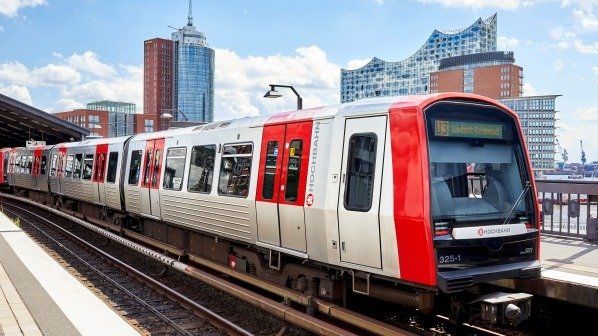Rolling stock across the world is a very large industry
Let’s start with some 2019 global statistics:
- There are 3.5 million pieces of rolling stock worldwide
- Railways carried over 30 billion passengers for 3 trillion kilometres
- 9 billion tons of freight was carried over 9 trillion kilometres
Year on year rolling stock industry grows
These stats show positive changes. With population growth the use of rail transport by passengers and freight has increased.
Hamburg U Bahn train
How much of 2050 net zero greenhouse gas targets refer to rolling stock?
2050 is the date agreed by the EU and other global leaders to cut greenhouse gas emissions to net zero. How much of this target includes reference to railway rolling stock? If none or little or an acquiescence that rolling stock will be carbon producing, there is a significant untapped opportunity to hugely improve fulfilment of the target as below.
By 2050 current rolling stock will be at end of its useful life
The rolling stock currently in use will become obsolete within a maximum of 30 years (i.e. by 2050), assuming a normal useful life and depreciation. Given this fact we have a responsibility to change the rolling stock to sustainable material.
Stainless steel supports carbon neutrality
Stainless steel supports this target including as follows:
- Stainless steel is 100% recyclable, as it is not coated with any toxic materials and there is no toxic runoff
- Stainless steel rail cars are far more durable than steel or aluminium equivalents, reaching up to 50+ years useful life
- During production, stainless steel uses scrap metal as its primary raw material with 70% coming from recycled material
- Advances in manufacturing technologies and use of energy-saving components have reduced railcar weight and consequential carbon benefits
- Increased efficiency in process technology has also decreased the amount of energy required to manufacture stainless steel
- Even stainless steel that reaches a landfill is environmentally friendly, not affecting the soil or groundwater
- Stainless steel is also much less adhesive to graffiti. Trains have been a “natural” canvas for many graffiti artists
Two million stainless steel pieces of rolling stock by 2050
Imagine if by 2050 a substantial volume of global rolling stock is made from stainless steel (say 2 million pieces of current 3.5 million that will be a much greater volume by 2050). The positive impact on the environment will be significant by both (i) reduction of materials that have a sizeable carbon footprint and (ii) use of alternative lower carbon stainless steel with durability to the end of 21st century (50 years useful life from 2050).
Arguments about stainless steel being more expensive don’t hold water
Some nay-sayers (worth finding out what vested interests they may hold) argue that stainless steel is a more expensive material than any of its alternatives. The importance of carbon neutrality on our planet’s integrity cannot be emphasised. This year 2019 we have actually observed some of these effects, for example global warming and considerable weather changes in many parts of the world. Any additional cost can be analysed, and of course in the context of the cost to our entire world. In any case stainless steel technology has also advanced over decades supporting a more cost-effective production process.
The technology of producing stainless steel rolling stock has already begun in the last century. Now’s time to make sure we leverage that technology:
- Switzerland’s Basel-based Tango is a light rail that since 2008 has been using stainless steel railcars in a very demanding environment, steep gradients and tight turns
- Hamburg’s metro and underground trains have since 2009 been using some stainless rolling stock. These trains are useful in difficult weather conditions and also highly corrosive gases from one of Europe’s largest harbours
- Spain’s Alicante coastline is served by stainless steel railcars
- Japan’s been using stainless steel railcars since middle of 20th century
- India’s massive population of 1.3 billion and land area with 3 million sq. kilometres requires a great deal of innovation in transport. India makes a substantial contribution to world rolling stock with 58,000 pieces and considerable volume of kilometres. India’s rail system has been making journeys since 1853. Highly advanced manufacturing includes laser cutting, robotic spot welding and much more. Stainless steel accounts for high percentages of annual railcar production and city-metro lines are also making significant use of stainless steel rolling stock
Nijen Stainless Fabrications
Nijen Stainless Fabrications wish you a happy festive season with safe travels, whichever mode of transport you may use and works with a number of industries and receives enquiries in relation to the following:
- Laser cutting
- Laser cutting Northern Ireland
- Stainless steel laser cutting
- Stainless steel laser cutting Northern Ireland
- Metal laser cutting
- Metal laser cutting Northern Ireland
- Stainless steel fabrication
- Stainless steel fabrication Northern Ireland
- Metal fabrication
- Metal fabrication Northern Ireland
- Stainless steel machining
- Stainless steel machining Northern Ireland
- Metal machining
- Metal machining Northern Ireland
- CNC machining
- CNC machining Northern Ireland
- Tube bending


